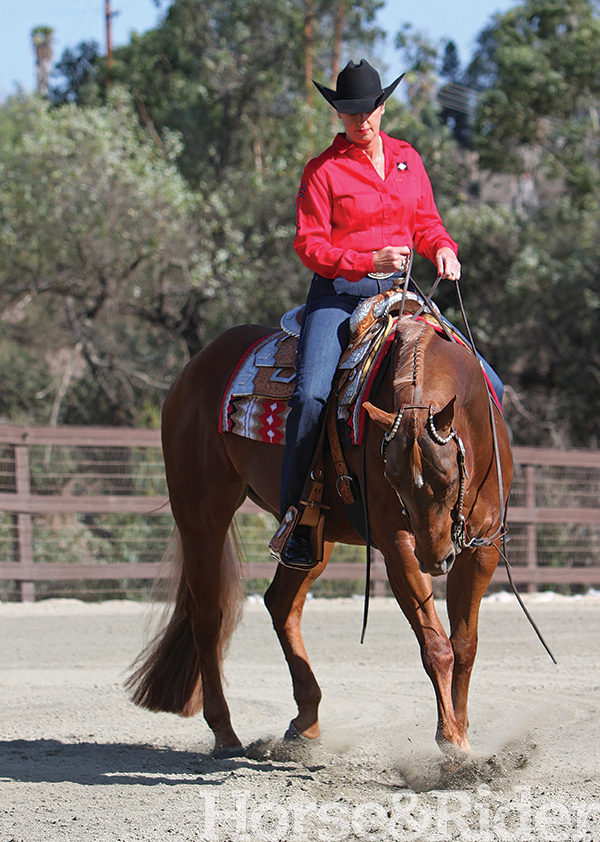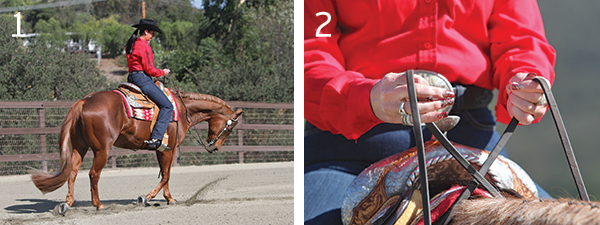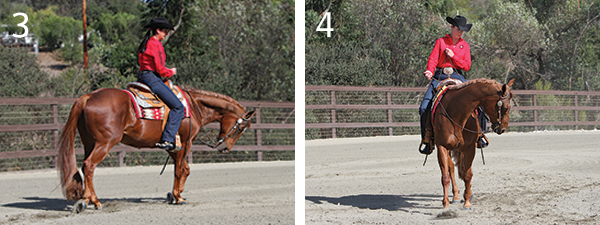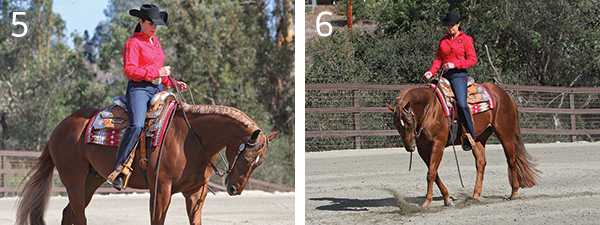Circling might seem like one of the most elementary exercises—really, who can’t travel a circle on their horse? The answer might surprise you. It’s one of the top things we spend time working on at our clinics and at home with our amateur and youth riders. Because most of them compete in all-around events, circling is important to each and every class they enter. Even barrel racers and reiners can benefit from this circling exercise.

For this drill, use a bit your horse responds to well, whether a snaffle or a shanked bit. Ride with two hands for the best body control. (You can advance to one-handed practice after mastering it with two.) Begin at a walk, then pick it up to a working jog once you’re comfortable. If possible, drag your arena just before you practice, so you can get a picture of what your circles look like before and after using our tips.
1. Jill is riding her horse at a trot in this photo to best demonstrate the exercise. It shows the overall look of her body position paired with her horse’s. Her hands control the front of her horse’s body, and her seat and legs keep the horse’s back end on track. As Jill rides along in this position, her tracks will fall on top of each other with each circle.

2. Hand position is critical for this drill. Jill has her reins crossed over the horse’s neck and holds them in an underhand position. This lets her jiggle her inside rein to slightly tip her horse’s nose to the inside of the circle while holding her outside rein steady to support her horse’s shoulders on the path. Other hand positions can be used if this isn’t comfortable, but be sure to keep your hands gentle for the best response. You don’t want to scare your horse by jerking the reins. Also, keep your reins as close to in front of your saddle horn as possible. Think “low and close together.”
3. Jill uses outside-leg pressure to keep the horse’s hindquarters to the inside of the circle. If her horse leans to the inside of the circle, she’ll use inside leg to square him up, along with a jiggling inside rein to help lift the horse’s shoulders. Her body position allows her to adapt to whatever her horse needs: more support for the outside hip, more guide from the inside rein, squaring up from the inside leg, or pushing the outside shoulder toward the circle with the outside rein.

4. With her hands too wide and high, Jill inadvertently guides her horse off the circle. Her horse’s nose is turned too far into the circle, and Jill’s hand position pushes her horse’s shoulders off the path. He’ll have to swing his hips off the circle, too, to accommodate for her overuse of her hands. That’s why the body and hand position discussed in Photo 3 is ideal for circle work.
5. Jill holds her horse’s inside shoulder up by jiggling her inside rein (her right in this case) to prevent leaning into the circle. She supports his outside shoulder with a steady left hand. If he starts to lean outside the circle, she can use more left-hand rein pressure to stand him back up squarely. With her legs, Jill drives her horse forward with her outside leg and can push his hips into the circle if he starts to fall out there. Her inside leg supports his barrel and helps him arc his body on the circle. With this position, they’re set up to work perfect circles.

6. You can see here that even after only a few times around the circle, Jill is making tracks that can tell her a story. If the tracks form a nice, round circle, then she and her horse are doing a good job with the drill and can try it one-handed. If she sees that her circle is lopsided or that the footfalls don’t follow the path, then she can address whether her horse needs more support with her legs or hands to get him tracking correctly.
Murray Griggs and Jill Newcomb combine their strengths as all-around trainers and experience as active judges to coach all-around riders and train their horses in San Marcos, California. They both grew up riding and competing and have earned top titles themselves in various events, as well as coaching champions. Learn more at jillandmurrayshowhorses.com.






